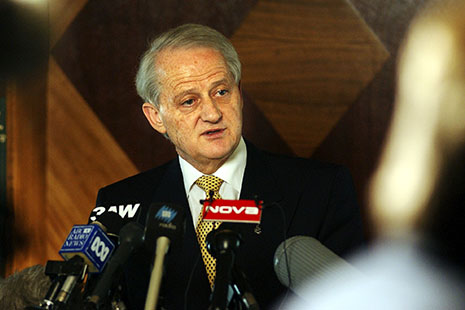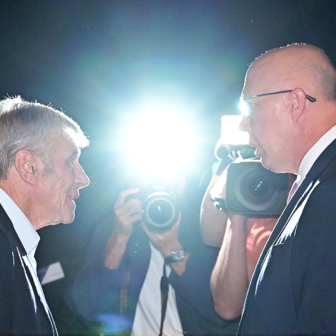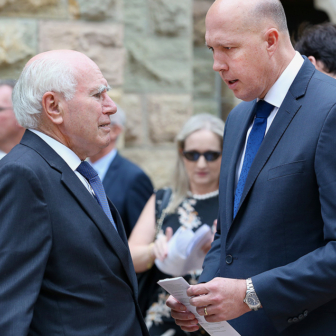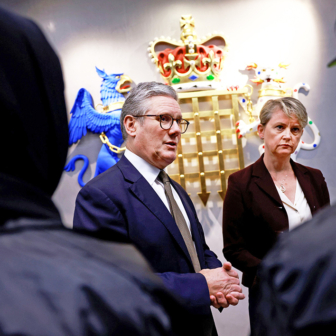THE Abbott government has revived the Howard-era policy of giving only temporary protection visas, or TPVs, to refugees who arrive in Australia without a valid entry permit. According to the most recent official statistics, there are almost 30,000 asylum seekers in Australia awaiting the outcome of their application for refugee status – about 23,000 of them living in the community on bridging visas and more than 6000 held in detention. As decisions are made on their cases, we are likely to see thousands of refugees experiencing intense anxiety about their uncertain futures, just as they did after TPVs were introduced in 1999. Community organisations and state and local government services will again be under pressure as they pick up the pieces of Commonwealth policy.
TPV holders are denied the right to permanent settlement or to family reunion. They cannot travel outside Australia without giving up the right to return. They are not given access to settlement services like free English language classes, and they must pay the same fees as international students if they want to study beyond high school.
The Howard-era regulations could have been disallowed by the combined vote of the non-Coalition parties in the Senate. But the federal Labor Party decided to vote with the government, even though Con Sciacca, the shadow minister for immigration, had told the ABC’s AM program that Labor tried a similar approach in government in 1990 and abandoned it as a costly failure.
In government, Labor abolished TPVs. Back in opposition, the party now has the capacity to stop TPVs being reintroduced by joining with the Greens and disallowing the visa regulations in the Senate.
Will Labor oppose the scheme, or is history about to repeat itself? In this edited extract from the 2002 edition of his book Borderline: Australia’s Response to Refugees and Asylum Seekers in the Wake of the Tampa Peter Mares tells the story of the Howard government’s TPV regime and its impact.
FINDING stable long-term accommodation is one of the biggest problems facing Australia’s new “temporary” refugees. They qualify for rent assistance and can join the queue for emergency accommodation or long-term public housing, but they are not eligible for financial support in meeting the initial costs of setting up a household (such as buying beds or fridges). And if the refugees have trouble settling into Australia, or need legal or financial advice, they will have to find help outside the traditional network of Migrant Resource Centres. These centres receive funding from the immigration department, but the minister, Philip Ruddock, has barred them from using Commonwealth funds to assist refugees on temporary protection visas.
Mr Ruddock makes no apology for this, and has warned other community groups not to use their immigration department funding to help people holding temporary protection visas. “It is certainly the case,” he told ABC TV’s Lateline, “that organisations funded to provide settlement services have been told that it is inappropriate to provide access to people who are here on a temporary basis.” He said that the support the refugees receive “was sufficient for Australians to remain viable in the community” and therefore “ought to be sufficient for these people.” Any additional services would only be an incentive for more people to come to Australia illegally. Mr Ruddock’s Liberal Party colleague and friend, John Olsen, then premier of South Australia, saw the situation rather differently. He told Four Corners that being denied English language classes would hardly act as a deterrent to people who “put their life into their own hands to take a boat trip across difficult waters to get to Australia.” Current Australian policy, according to Mr Olsen, creates “two classes of refugees.”
When it comes to Australia’s new “temporary” refugees, the federal government has all but deserted the field. It falls to state governments and local communities to fill in the gaps between the bare boards of Centrelink payments and Medicare benefits. As premier of South Australia, John Olsen authorised the use of state resources – such as the TAFE system for English language training – to fill the void in services left by the Commonwealth. Similar initiatives have been taken in some other states. In Tasmania the state government provided grants to local councils to provide support services to TPV holders. In Victoria the state government paid the salary of a coordinator to help manage and organise services for “temporary” refugees and funded projects designed to assist them to settle into Australian society, through support with training, education and job hunting.
While the Labor government in Victoria has voiced its opposition to the TPV policy, the state government of Queensland has gone one step further, adopting a formal policy that state based agencies will not discriminate between refugees who hold TPVs and refugees with a permanent right to stay in Australia. Both “classes” of refugees are eligible for the same level of services. In response to these initiatives the immigration minister issued a press release accusing Labor state governments of “funding incentives which will be used by people smugglers to encourage unlawful arrivals to Australia.”
VISITING The Parks, a suburb in Adelaide’s northwest, I meet four men and one fifteen-year-old boy — a dentist, a shopkeeper, a shepherd, a farmer who is constantly fingering prayer beads, and the farmer’s son. Sameer, their case worker, and Mohammed, the shopkeeper, act as dual interpreters.
The men are agitated, concerned for their short-term future. Their stay in this house has been limited to four weeks, and half of that time has already elapsed. Sameer managed to find the accommodation by twisting the arm of a contact in the state housing commission. “They bent their own rules,” Sameer tells me, “otherwise these guys would have been on the street and nowhere else.” Sameer also feels hassled. He has no idea where he can accommodate the men next. “The government is relying on local communities to help these people, but they don’t know what to do,” Sameer tells me. “You are asking for help from people who are already relatively powerless.”
The men all express a desire to learn and to work. They want help, but not handouts. “I do not like to get the special benefit,” says Gulzari the dentist. “I would much rather work by my own hand. I know that they will not let me work as a dentist, but I hope that they will let me study some kind of course.”
Their biggest concern is for their families, scattered across Afghanistan, Pakistan and Iran. “The new law is very harsh on us,” says Mohammed, referring to the TPV. Under the terms of the visa, the refugees cannot apply to sponsor their families to join them in Australia for at least three years; nor can they leave Australia to visit relatives living in safe countries abroad. “It is causing lots of anxiety and stress,” says Sameer. “Still, we say thank you to Australia that they have accepted us here,” adds Mohammed. “Our lives were in danger because of the Taliban. If they deported us back to Afghanistan, we would have been killed.”
I get a deeper insight into the agony of the “temporary” refugee when I meet Hakim, another Afghan. In June 2000 he is living in an outer suburb of Melbourne, sharing a flat with a compatriot and, despite the restrictions on his visa, he has even managed to find some free English lessons. But Hakim does not feel grateful to Australia; in fact, he is angry and upset. This is not immediately obvious when we first meet.
“I am living like a single man,” Hakim apologises, smiling warmly as he invites me in and immediately warms a bowl of spiced mutton soup in an aluminium saucepan. The flat is modest but tidy, a small gas stove keeps the cold at bay, and daytime television burbles away from a battered white portable on a desk in the corner. As our conversation proceeds, the television’s cheery tone becomes more and more incongruous.
Hakim is forty-four, a father of five children and a grandfather of at least two. He’s not sure whether there may be more because he does not know the whereabouts of his wife and four of his children. Since he was jailed in 1994 Hakim has only had contact with his oldest daughter, who is living in Iran.
Hakim’s anguish is caused by the knowledge that, while he is now safe, he must wait at least three years before he can do anything to trace his family or bring them to Australia. He wants to be allowed to go back to Pakistan or Iran to look for them, but this is impossible under the terms of his visa. Adding to Hakim’s uncertainty is the question of whether he will be allowed to settle in Australia permanently when his temporary visa expires. “If I stay here, I work, I read, I help Australian people,” he says. “I buy a house, I plant a garden. I think like an Australian. Now I think like an Afghan, because maybe after two or three years, I have to go back.”
During our conversation, Hakim’s mood has shifted markedly. Bright at first, he is now increasingly morbid. He often rubs his palms against his forehead, drawing them down hard across his cheeks, as if trying to push away the pain. “To come to Australia is a bad chance for me,” he keeps repeating, angry at the treatment he has received, treatment he regards as dishonest. “When you came to my door,” he says, “I helped you. I invited you in and offered you food. If I could not help you, I would say, ‘Sorry, I can’t help you, please go away.’ If I invite you in, but offer you no food, offer you no bed to sleep in, then you would say, ‘Why did you ask me to come in at all, if you cannot help me?’ It is better to be honest at first, direct, face-to-face. Better for Australia to say, ‘I can’t help you, I don’t want refugees here.’”
Hakim uses his hands to describe the pressure he feels – two clenched fists, pushing against one another. “Pressure this way and this way,” he says. “When I don’t know where my future is, then the depression problem comes back. There is no interest in living for me. Sometimes when I get out of bed in the morning, I am thinking, ‘Why I am living? Here is not my family or my children. For what are you living?’”
Hakim is making a supreme effort to keep a hold on life. He takes antidepressants and attends regular counselling sessions at Foundation House for the survivors of torture (one of the few services not denied to “temporary” refugees). He is busy learning English, picking it up again for the first time since he was a teenager, when he was top of his class. Back then he was taught by a friendly American called Paul, who gave Hakim his black Chinese bicycle when he departed Afghanistan. It is a fond memory of a time before the Soviet invasion, a time when life still held promise.
THE TPV policy also puts added stress on the bureaucracy of the immigration department itself. There are now some 8000 TPV holders in Australia. Unless they decide to leave Australia voluntarily, all these refugees will have to have their cases reviewed after thirty months, to determine whether or not they are still at risk of persecution in their homeland. This amounts to a repeat of the whole refugee determination procedure, both at the primary level and at the appeal level through the Refugee Review Tribunal.
The most severe costs of government policy will be felt by the Australian community as a whole, because the TPV creates a marginalised and distraught community of refugees who live among us but not with us. As a result, these “temporary” refugees are likely to become high demand users of health and welfare services. As former human rights commissioner Chris Sidoti writes in the foreword to a report on TPV holders in the state of Victoria, “Is it in our own interest as Australians to have people here for periods of years who are insecure, traumatised, denied assistance to learn English, accorded a discriminatory status that inhibits their integration into the broader community, left unsupported by and worried about their spouses and children? Surely and self-evidently it is not.”
The report he was introducing – Politics of Social Exclusion: Refugees on Temporary Protection Visas in Victoria – identified “despair, disillusionment and unusually high levels of anxiety and health disorders” among refugees on TPVs. It also documented the difficulty faced by “temporary” refugees in finding work, a problem not only due to poor English language skills and the lack of other training opportunities. Even refugees with professional qualifications and fluent English encounter problems because their insecure residency status makes them unattractive to prospective employers. All the refugees interviewed for the report expressed their appreciation for the special benefits payments they received via Centrelink, but said they nevertheless felt “insulted” by this government hand-out and would much rather be working.
“Visa restrictions are not benefiting anyone including the government,” stated one of the TPV holders, who believed that if people had access to education and training, their increased rate of employment and/or business establishment would reduce the money the government is paying in benefits. Indeed, he added, “the working person will be paying the government with taxes.” Another woman participant added that this kind of approach would reduce isolation, and improve self-esteem and self-image, which in return will reduce the demand on mental health and physical health services.
When a reporter from SBS TV’s Insight program raised these concerns directly with Minister Ruddock in March 2002, he refused to acknowledge that there was a problem. He described the provision of English language education to refugees as “delivering a service which helps someone in their life… [that]… doesn’t necessarily make our situation as an Australian community any better and more effective.” The reporter pressed Mr Ruddock on the issue, suggesting that forcing people to remain on the margins of society could not be beneficial to social cohesion. The minister responded by suggesting that the reporter wanted to “embrace” people who had broken Australian law and who had taken the place of a refugee in far greater need. “And what I’m saying is, ‘No, that embrace is not there.’” •




